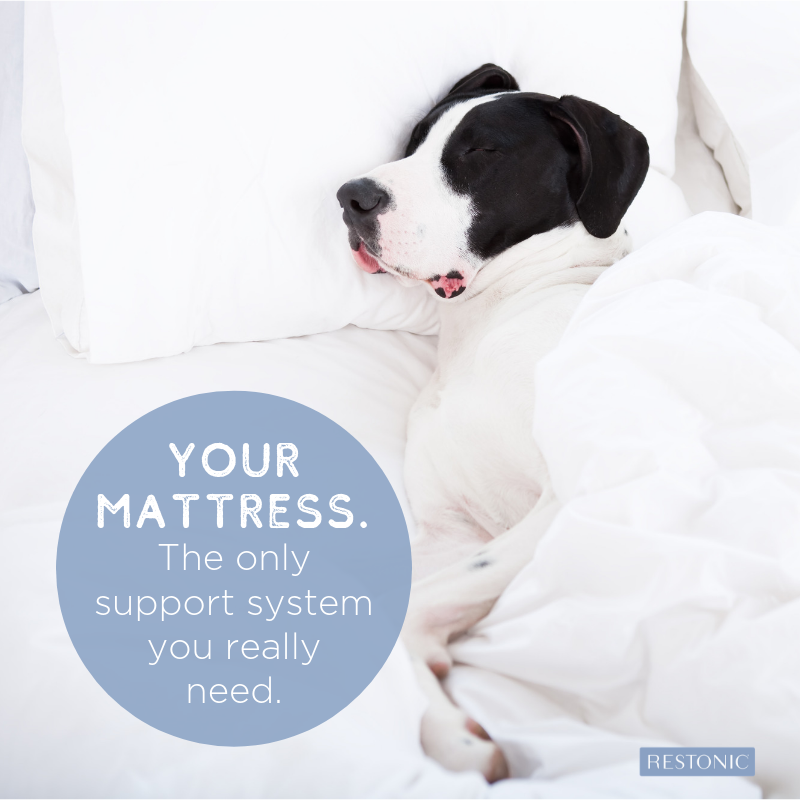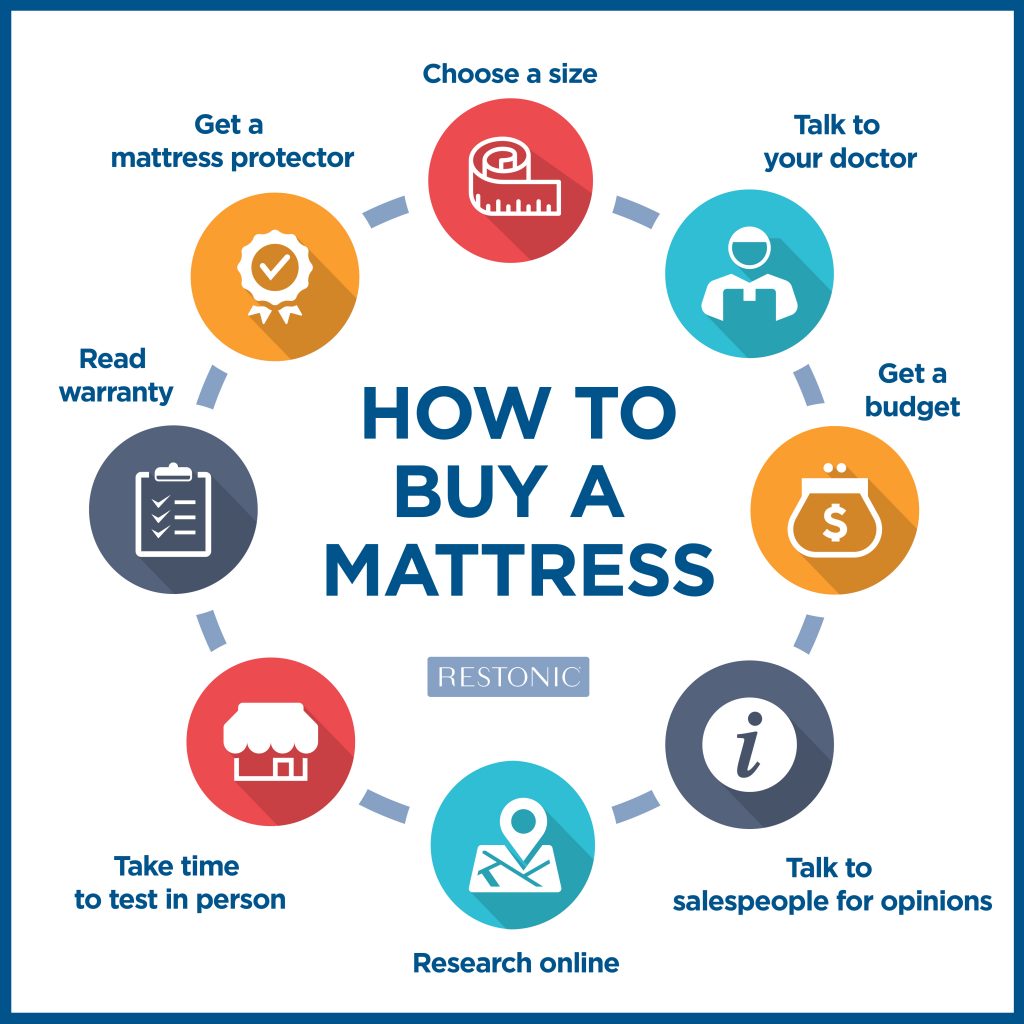When you go to sleep, your mattress should go to work
Most people rank buying a new mattress right up there with a visit to the doctor. Necessary but far from enjoyable. But did you know, back pain and sore throats are the most common health issues that require medical attention? So, if we’re willing to eat our veggies to prevent a round of antibiotics, shouldn’t we invest in preventing the sore back too?
Sleep is your body’s chance to recover from the day’s stresses and strains and a supportive sleep surface can be powerful medicine. According to the American Sleep Research Institute, most Americans believe a better quality mattress leads to a better night’s sleep – but almost half of us sleep on an uncomfortable mattress.
The science of pressure points, mattresses & your health
 Pressure mapping – how weight is distributed across the surface of a mattress – is as much a science as it is an art. Just as our sleep patterns are unique, so is the way we lie on our mattresses. Some of us curl into a tight ball, while others splay their limbs wide, stretching out to each corner. Side sleepers, back sleepers, tummy sleepers, some make a tent with their knees, while others hang a foot over the edge – our sleep positions are almost as unique as our finger prints.
Pressure mapping – how weight is distributed across the surface of a mattress – is as much a science as it is an art. Just as our sleep patterns are unique, so is the way we lie on our mattresses. Some of us curl into a tight ball, while others splay their limbs wide, stretching out to each corner. Side sleepers, back sleepers, tummy sleepers, some make a tent with their knees, while others hang a foot over the edge – our sleep positions are almost as unique as our finger prints.
Almost.
When a mattress is designed, the first task is mapping the areas that will support the person (or people) using it. When you lie down, your buttocks to your shoulders – your torso – are the heaviest while your head, knees and feet are lightest. Every mattress has a unique set of features designed to support and comfort those different areas of the body, ensuring that people who sleep curled into a ball are as comfortable as the ones who sleep spread eagle.
Mattress manufactures today understand that comfort and support are equally important. What’s inside your mattress, the layer of materials, help support the spine and joints while, at the same time, offering pressure-point relief to the entire body. Some mattress manufacturers do a better job of pressure mapping than others.
Comfort layer of your mattress
When you first lie down on your mattress, the immediate feeling of cushy or firm comes from the materials used in the upholstery layers directly above the core support system (which could be innerspring, latex or memory foam). A hybrid mattress, the most popular choice in the market today, uses a variety of advanced comfort foams and fibers designed to enhance cushioning and deliver pressure-point relief.
The average person moves as much as 75 times a night. During the deepest phase of sleep, REM sleep, movements can happen every 6 to 8 minutes. “Movement while we are asleep is a protective mechanism to prevent problems developing from prolonged pressure — such as reduced blood flow to certain parts of the skin,” says Dr. Peter Roessler, a fellow of the Australian and New Zealand College of Anesthetists.
A mattress that offers pressure-point relief in the comfort layer reduces tossing and turning throughout the night, which allows you to achieve a deeper, more restorative sleep. If nothing hurts, you won’t feel the need to move as much. Imagine if you slept on a mattress that allowed you to move less and enjoy a deeper, longer sleep.
Support layer of your mattress
The support layer of a mattress can be made from coil innerspring, latex or memory foam – or a combination. A good quality mattress will support your back, allowing it to relax into its natural “S” shape while you sleep.
Latex and foam mattresses allow you to stretch your body across a buoyant surface that supports lighter and heavier parts equally. Unilateral support across the mattress allows you stay in one position for longer periods without feeling the need to move. And when you do roll over, motion isn’t reciprocated across the sleep surface to your partner. In fact, the bounce-factor on a latex and/or foam mattress is almost non-existent, which also eliminates the kids jumping on your bed.
If you sleep on an innerspring mattress, the number of coils varies from manufacturer to manufacturer and is based on the size of a mattress. Obviously a twin mattress will have less coils than a king but coil count is not necessarily as important as the construction. How the coils are made and the strength and resiliency of the steel are a better indicator of the quality and longevity of your mattress.
Finding the right mattress for your body
We’re all uniquely built and it’s no secret that our bodies age differently, molded by the sports we play or don’t play, not to mention the stress we weather over a lifetime. The results are spinal deviations, muscular tensions and weight distribution that require our mattresses work hard – much harder than they did generations ago.
 If you’re in the market for a new mattress, get up close and personal with your sleep habits (and your partner’s if you share a bed with someone) before you begin shopping. Pay attention to how you fall asleep, how you wake up and what hurts in the morning. Do you wake often at night and is your night waking from pain or something else like temperature or stress? Do you snuggle under the covers or throw them off? Being aware of how you sleep will help you decide what kind of mattress is better for you.
If you’re in the market for a new mattress, get up close and personal with your sleep habits (and your partner’s if you share a bed with someone) before you begin shopping. Pay attention to how you fall asleep, how you wake up and what hurts in the morning. Do you wake often at night and is your night waking from pain or something else like temperature or stress? Do you snuggle under the covers or throw them off? Being aware of how you sleep will help you decide what kind of mattress is better for you.
You might prefer the buoyancy of a latex or memory foam mattress or maybe innerspring suits your needs better – or maybe you’re interested in learning more about hybrid mattress technology. The best way to learn which kind of mattress is best for you is to go to a store and try out lots of mattresses. Once you’ve narrowed down your choices, be prepared to spend at least 10 minutes on each of your top picks.
Take your time. Buying a new mattress is important. What’s the cost of a good night’s sleep? If you spent $2,000 on a new mattress (for example) and slept comfortably on that mattress for 7 years, the cost of healthy sleep would be $1.27 per night – less than the cost of a Starbucks coffee in the morning…
Rest well & wake up ready to go!
Better sleep gives rise to better mornings, bringing your goals into focus and dreams within reach. Hungry for more sleep info? Dig into these posts:
Eager for more sleep info you can really use?
Join our community
Facebook
and let's continue the conversation.
We'd love to hear what you have to say!
This blog does not provide medical advice. It is intended for general informational purposes only and does not address individual circumstances. It is not a substitute for professional medical advice, diagnosis or treatment and should not be relied on to make decisions about your health. Never ignore professional medical advice in seeking treatment because of something you have read on Restonic.com. If you think you may have a medical emergency, immediately call your doctor or dial 911.

